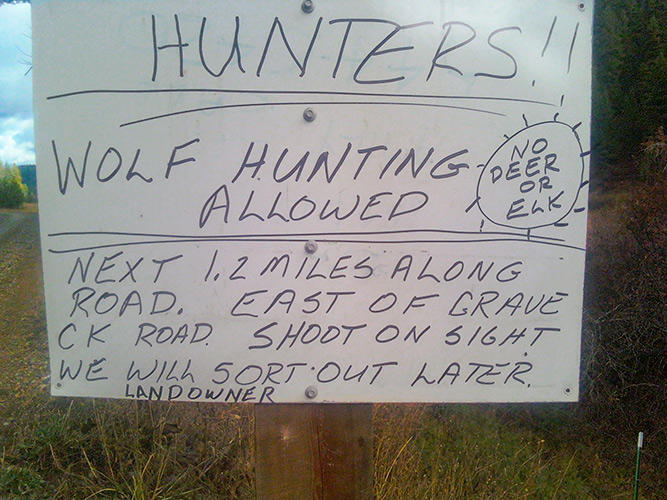Commission will decide today whether an Idaho wolf hunt will be accepted by wolf conservationists or whether a bitter battle begins-
Update: Commission sets wolf quota at 220 wolves.
More information will follow when I get it. Here is some. Idaho’s wolf hunting limit set at 220. Idaho Statesman. From what I read, including the comments in the Statesman, it looks like I’m shaping up as a moderate on this one.
The Idaho Fish and Game Commission meets in Idaho Falls today to set the wolf kill quota just 2 weeks before the wolf season begins. Tags will go on sale Aug. 24. In July, Montana set a wolf quota of 75 after seeking public comment and developing computer models of various quotas and their estimated effect on wolf populations.
Idaho hasn’t sought public input. As I write this, how the quota was determined is not clear. Some indications are they will have a quota as high as 500 to 700 wolves. Idaho has the best wolf habitat in the lower 48 states as indicated by its current population of perhaps 1000 wolves compared to adjacent Montana with just half as many despite having wolves in the state since the 1980s, beginning with natural in-migration from Canada.
Some people think wolf hunting will prove difficult and the quota won’t be filled. Outdoor writers Rocky Barker of the Idaho Statesman is a well know person who holds to this school of thought. Others believe there will be a slaughter — wolves being easy to find while elk or deer hunting coupled with a very long hunting season. I tend to the latter because of the length of the season and the likelihood that a fair number of hunters will shot two, tag one, and leave the other.
My view is that I am not against a wolf hunt, but a real hunt of any game animal does not as its purpose reduce the population by very much. If the Commission announced they were going to reduce the state’s elk population by half, for example, that would not be a hunt. Of course, they wouldn’t do that.
Because wolves have not been hunted before in Idaho, and Idaho so much different geographically than Alaska, a lot of information needs to be gathered. It will be important to see if the Commission puts in place a mechanism to gather critical information, especially so that they can see if a wolf hunt (or reduction) has any effect on elk, deer, or moose populations. Will wolves become more wary of humans?
It is also important to see if the hunt has an effect on livestock depredations. Conventional wisdom is that a reduction in wolves will reduce the number of sheep and cattle killed, but others believe that because wolves are a pack animal and learn what is prey from their pack, disrupted packs will send orphaned pups, wounded wolves and subadults into the herds of livestock.
I for one, would not protest a quota of 100 or 200 animals (comparable to Montana), not that I think any hunt is a biological necessity. However, a high quota with lax oversight will spark a bitter battle. It’s all up to the Fish and Game Commission what they want. For those who want the wolf relisted, a high quota with lax enforcement is more likely to yield success in their lawsuit than a more measured approach. Montana’s Commission (Fish, Wildlife and Parks) seemed to sense that.
Idaho Fish & Game to set limits for first wolf hunt. By Roger Phillips. Idaho Statesman.
Idaho officials to set wolf hunt quotas today. Associated Press







![[]](https://i0.wp.com/www.biologicaldiversity.org/species/mammals/Mexican_gray_wolf/images/Brunhilda_USFWS.jpg)
